Indonesian Army
| Indonesian Army | |
|---|---|
|
Tentara Nasional Indonesia-Angkatan Darat TNI-AD | |
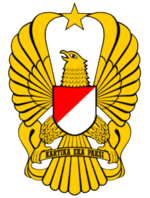 TNI-AD insignia | |
| Active | 15 December 1945 – present |
| Country |
|
| Allegiance |
|
| Type | Army |
| Role |
|
| Size | 300,000[1] |
| Part of | Indonesian National Armed Forces |
| Motto(s) |
Kartika Eka Paksi (Sanskrit, lit: "Unmatchable Bird with Noble Goals") |
| Colours | Red White Gold |
| Anniversaries | 15 December 1945 |
| Engagements |
Indonesian Independence Darul Islam Rebellion Indonesia–Malaysia confrontation East Timor Invasion Counter-insurgency in Aceh Counter-insurgency in Maluku Papua conflict Operation Tinombala |
| Website |
www |
| Commanders | |
| Commander-in-Chief | President Joko Widodo |
| Chief of Staff | General Mulyono |
| Vice Chief of Staff | Lt.Gen. Tatang Sulaiman(id) |
| Notable commanders |
Sudirman Urip Sumohardjo Djatikoesoemo Mustopo T.B. Simatupang Abdul Harris Nasution Gatot Subroto Slamet Rijadi Achmad Yani Hasan Basry |
| Insignia | |
| Army Aviation Roundel & Fin Flash |
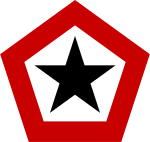  |
The Indonesian Army (Indonesian: Tentara Nasional Indonesia-Angkatan Darat (TNI-AD), literally "Indonesian National Military-Land Service"), the land component of the Indonesian National Armed Forces, has an estimated strength of 300,000 active personnel.[1] The history of the Indonesian Army has its roots in 1945 when the Tentara Keamanan Rakyat (TKR) "Civil Security Forces" first emerged as a paramilitary and police corps.[2]
Since the nation's independence movement, the Indonesian Army has been involved in multifaceted operations ranging from the incorporation of Western New Guinea, the Indonesia-Malaysia Confrontation, to the annexation of East Timor, as well as internal counter-insurgency operations in Aceh, Maluku, and Papua. The army's operations have not been without controversy; it has been periodically associated with human rights violations, particularly in West Papua, East Timor and Aceh.[3][4]
The Indonesia Army is composed of a headquarters, 15 military region commands, a strategic reserve command KOSTRAD, a special forces command Kopassus, and various adjunct units.
History
Formation
In the week following the Japanese surrender of 1945, the Giyugun (PETA) and Heiho groups were disbanded by the Japanese. Most PETA and Heiho members did not yet know about the declaration of independence. Command structures and membership vital for a national army were consequently dismantled. Thus, rather than being formed from a trained, armed, and organised army, the Republican armed forces began to grow in September from usually younger, less trained groups built around charismatic leaders.[5] Creating a rational military structure that was obedient to central authority from such disorganisation, was one of the major problems of the revolution, a problem that remains through to contemporary times.[6] In the self-created Indonesian army, Japanese-trained Indonesian officers prevailed over those trained by the Dutch. A thirty-year-old former school teacher, Sudirman, was elected 'commander-in-chief' at the first meeting of Division Commanders in Yogyakarta on 12 November 1945.[7]
Aware of the limitations of the military in the face of the Dutch aggression, the people and government of Indonesia had no choice but to fight foreign threats to the young nation's independence. Thus, in 1947, the People's War Doctrine in which all the power of the national armed forces and the community and resources were deployed to confront the Dutch aggression, was officially implemented within the army and the wider armed forces as the national military strategy. Thus, the integrity and existence of the Unitary Republic of Indonesia has been able to be maintained by military force with the people. In accordance with the decision of the Round Table Conference (RTC), at the end of 1949 the United States of Indonesia (RIS) came into being. Correspondingly, the TNI's ground forces thus formed part of the Angkatan Perang Republik Indonesia Serikat (APRIS) (later the Angkatan Perang Republik Indonesia or APRI when the republic became unitary in 1950). It would be the merger of the TNI and the former KNIL and all military personnel of the two forces, plus the independent paramilitary groups (laskar) which fought the war on the side of the independence movement.
Action against rebellions
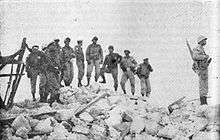
The period is also called the period of liberal democracy is characterized by various rebellions in the country. In 1950 most of the former members of the Colonial Army launched an uprising in Bandung which is known as the Legion of Ratu Adil / APRA uprising and was led by former KNIL officer Raymond Westerling. The army also needed to confront the uprising in Makassar led by Andi Azis and the Republic of South Maluku (RMS) in Maluku. Meanwhile, DaruI Islam in West Java widened its influence to South Kalimantan, South Sulawesi and Aceh. In 1958 the Revolutionary Government of the Republic of Indonesia / People's Struggle (PRRI / Permesta) started a rebellion in large parts of Sumatra and North Sulawesi endangering the national integrity. As part of the National Armed Forces the Army helped defeat all these uprisings, increasing its prestige in the eyes of the government and the people. Future Chief of Staff of the Army Ahmad Yani was instrumental in one of these first victories against rebels in Central Java.
On 17 November 1952, General Nasution was suspended as army chief of staff following army indiscipline over command and support that threatens the government. From the 1950s, the military articulated the doctrines of dwifungsi and hankamrata, the military roles in the country's socio-political development as well as security; and a requirement that the resources of the people be at the call of the armed forces and police if the State warrants it. On 5 July 1959, Sukarno, with armed forces support and the advice of Nasution, issued a decree dissolving the Constituent Assembly and reintroducing the Constitution of 1945 with strong presidential powers. By 1963, he also assumed the additional role of Prime Minister, which completed the structure of 'Guided Democracy', and was named "President for Life", also with army assistance, the year after.
At the same time, the Indonesian government started sending their troops on UN peacekeeping missions. The first batch of soldiers were sent to Sinai, Egypt and were known as Garuda Contingent 1. Garuda Contingent I began its first deployment January 8, 1957 to Egypt. Garuda Contingent I consisted of the combined personnel of the 15th Army Infantry Regiment Territorial Command (TT) IV / Diponegoro, as well as one company of the 18th Infantry Regiment TC V / Brawijaya in Malang. This contingent was led by Lt. Col. of Infantry Hartoyo which was later replaced by Lieutenant Colonel of Infantry Suadi Suromihardjo, while his deputy was Major of Infantry Soediono Suryantoro. The contingent departed on January 8, 1957 on board the Douglas C-124 Globemaster II transport aircraft of the United States Air Force for Beirut, the Lebanese capital. From Beirut the contingent was divided by two, the majority heading to Abu Suweir and partly to Al Sandhira. Furthermore, the El Sandhira troops moved into Gaza, the border area of Egypt and Israel, while the command is in Rafah. This contingent returned to Indonesia on September 29, 1957. Garuda Contingent I had a total number of 559 army personnel of all ranks.
1960 onwards
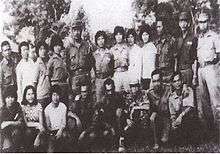
The army was heavily involved in the Indonesian killings of 1965–1966. The killings were an anti-communist purge following a failed coup of the 30 September Movement. The most widely accepted estimates are that more than 500,000 people were killed. The purge was a pivotal event in the transition to the "New Order"; the Indonesian Communist Party (PKI) was eliminated as a political force. The failed coup released pent-up communal hatreds which were fanned by the Indonesian Army, which quickly blamed the PKI. Communists were purged from political, social, and military life, and the PKI itself was banned. The massacres began in October 1965, in the weeks following the coup attempt, and reached their peak over the remainder of the year before subsiding in the early months of 1966. They started in the capital, Jakarta, and spread to Central and East Java and, later, Bali. Thousands of local vigilantes and army units killed actual and alleged PKI members. Although killings occurred across Indonesia, the worst were in the PKI strongholds of Central Java, East Java, Bali, and northern Sumatra. It is possible that over one million people were imprisoned at one time or another.
Sukarno's balancing act of "Nasakom" (nationalism, religion and communism) had been unravelled. His most significant pillar of support, the PKI, had been effectively eliminated by the other two pillars—the army and political Islam; and the army was on the way to unchallenged power. In March 1968, Suharto was formally elected president.
The killings are skipped over in most Indonesian history books and have received little introspection by Indonesians and comparatively little international attention. Satisfactory explanations for the scale and frenzy of the violence have challenged scholars from all ideological perspectives. The possibility of a return to similar upheavals is cited as a factor in the "New Order" administration's political conservatism and tight control of the political system. Vigilance against a perceived communist threat remained a hallmark of Suharto's thirty-year presidency. The CIA described the massacre as "one of the worst mass murders of the 20th century, along with the Soviet purges of the 1930s, the Nazi mass murders during the Second World War, and the Maoist bloodbath of the early 1950s."[8]
Later army operations have not been without controversy; it has been periodically associated with human rights violations, particularly in West Papua, East Timor and Aceh.[3][4] Involvement in UN Peacekeeping operations continued, but in 2010, the United Nations Interim Force in Lebanon was strongly criticized after two soldiers from Indonesia were filmed fleeing a clash on the Israeli-Lebanon border in a taxi.[9]
The size of the Army has expanded over the years; in July 1976 the Army was estimated to consist of solely 180,000 personnel, one armoured cavalry brigade, part of Kostrad (one tank battalion, plus support units), 14 infantry brigades (90 infantry, 1 para, 9 artillery, 11 anti-aircraft, and 9 engineer battalions) of which three of the brigades were in Kostrad, two airborne brigades totalling six battalions, also part of Kostrad, one independent tank battalion, 7 independent armoured cavalry battalions, and four independent para-commando battalions.[10][10]
Organisation
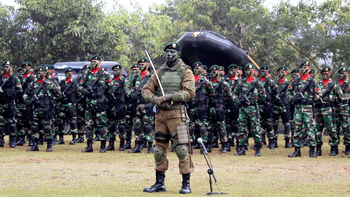
The Indonesian Army is currently organized into 15 military area commands which are spread throughout the Indonesian archipelago. They are placed under the jurisdiction of the army headquarter. Three are based in Sumatra, four are based in Java, two are based in Kalimantan, one based in Lesser Sunda Islands, two based in Sulawesi, one based in Maluku and two based in Papua. The Komando Cadangan Strategis Angkatan Darat (reserve forces) and Komando Pasukan Khusus (special forces) are independent formations and directly subordinate to the Chief of Staff. The army headquarters is under coordination with the armed force Headquarters. The highest-ranking officer within the army is the Chief of Staff of the Army which has the rank of a four-star General and is responsible to the Commander of the Armed Forces.
The Indonesian Army is structured into the following in accordance with the provisions of presidential decree No. 62/ 2016:[11]
Leadership Element
- Chief of Staff of the Indonesian Army, position held by a four-star general.
- Vice Chief of Staff of the Army, position held by a three-star general.
Assistant for Leadership Element
- Inspector General of the Army, position held by two-star general.
- Army Expert Advisor, position held by two-star or one-star general.
- Army Planning and Budgeting Advisor
- Army Security Advisor
- Army Operational Advisor
- Army Human Resources Advisor
- Army Logistics Advisor
- Army Territorial Advisor
Central Executive Agencies under Army Headquarters
The agencies with suffix Pusat, Direktorat, Akademi, and Sekolah are headed by two-star general, while agencies with suffix Dinas are headed by a one-star general.
- Army Aviation Command (Pusat Penerbangan TNI Angkatan Darat)
- Army Military Police Command (Pusat Polisi Militer TNI Angkatan Darat)
- Army Territorial Forces Command (Pusat Teritorial TNI Angkatan Darat), In charge of fostering and conducting Territorial defense functions in order to support the basic tasks of the Army.
- Army Medical Department (Pusat Kesehatan TNI Angkatan Darat), in charge of maintaining the health of army service personnel and assisted by Gatot Soebroto Army Hospital
- Army Intelligence Command (Pusat Intelijen TNI Angkatan Darat), provides intelligence gathering services to the Army.
- Directorate of the Army Corps of Engineers (Direktorat Zeni TNI Angkatan Darat)
- Directorate of the Army Signals Corps (Direktorat Perhubungan TNI Angkatan Darat)
- Directorate of the Army Ordnance Corps (Direktorat Peralatan TNI Angkatan Darat)
- Directorate of the Army Logistics Corps (Direktorat Pembekalan Angkutan TNI Angkatan Darat)
- Directorate of the Army Adjudant General (Direktorat Ajudan Jenderal TNI Angkatan Darat)
- Directorate of the Army Topography Service (Direktorat Topografi TNI Angkatan Darat)
- Directorate of the Army Justice Service (Direktorat Hukum TNI Angkatan Darat)
- Directorate of the Army Finance Corps (Direktorat Keuangan TNI Angkatan Darat)
- Army Physical Fitness and Sports Commission (Dinas Jasmani TNI Angkatan Darat), In charge of physical fitness functions including the formation, upgrading and maintenance towards personnel and units within the Army organization.[12]
- Army Chaplaincy Corps (Dinas Pembinaan Mental TNI Angkatan Darat). This agency is in charge of organizing mental guidance for soldiers and civil servants and their families through mentality of spiritual and ideological mentoring in order to support the main task of the Army.
- Army Psychology Service (Dinas Psikologi TNI Angkatan Darat), In charge of psychological affairs towards Army personnel and servicemen in order to support Army operational conducts. This agency is also involved in selection of candidates, career development and personality of member personnel, psychological feasibility evaluation of members, development of research related to psychology and army in the field of social, war strategy, and planning.
- Army Research and Development Service (Dinas Penelitian dan Pengembangan TNI Angkatan Darat), Responsible for planning and developing equipment and facilities for the army and led by a brigadier general.
- Army History Service (Dinas Sejarah TNI Angkatan Darat) - Responsible for research studies and on activities on promoting and preserving the history and heritage of the Army.
- Army Information and Data Processing Service (Dinas Informasi dan Pengolahan Data TNI Angkatan Darat)
- Army Public Relations and Media Department (Dinas Penerangan TNI Angkatan Darat), In charge of delivering information and explanation of activities and incidents associated with the Army to the public in order to support the operational duties of the Army.
- Army Quality Assurance Service (Dinas Kelaikan TNI Angkatan Darat)
- Indonesian Military Academy (Akademi Militer / Akmil)
- Army General Staff College (Sekolah Staf dan Komando TNI Angkatan Darat/ Seskoad)
- Army Officer Candidate School (Sekolah Calon Perwira TNI Angkatan Darat / Secapa TNI AD)
Principal Commands under the Army Headquarters
Army Strategic Command

![]()
Army Doctrine, Education and Training Development Command
The Army Doctrine, Education and Training Development Command (Komando Pembinaan Doktrin, Pendidikan dan Latihan TNI AD or Kodiklatad) is mandated to provide training to all officers, warrant officers, NCOs and enlisted personnel of the Army.
- Kodiklatad HQ, located in Bandung, West Java
- Infantry Branch Centre (Pusat Kesenjataan Infanteri (Pussenif)) located in Bandung
- Cavalry Branch Centre (Pusat Kesenjataan Kavaleri (Pussenkav)) located in Bandung
- Air Defense Artillery Branch Centre (Pusat Kesenjataan Artileri Pertahanan Udara (Pussenarhanud)) located in Cimahi
- Field Artillery Centre (Pusat Kesenjataan Artileri Medan (Pussenarmed)) located in Cimahi
- Combat Training Centre (Pusat Latihan Tempur TNI AD (Puslatpur TNI AD)) located in Baturaja
- Combat Simulation Centre (Pusat Simulasi Tempur TNI AD (Pussimpur TNI AD)) located in Bandung
- Army Branch Training Centres (Pusdik Kecabangan):
- Infantry Training School (Pusat Pendidikan Infanteri (Pusdikif)) in Bandung
- Cavalry Training School (Pusat Pendidikan Kavaleri (Pusdikkav)) in Padalarang
- Air Defense Artillery Training School (Pusat Pendidikan Artileri Pertahanan Udara (Pusdikarhanud)) in Malang, East Java
- Field Artillery Training Centre (Pusat Pendidikan Artileri Medan (Pusdikarmed)) in Cimahi
- Women's Army Corps Training School (Pusat Pendidikan Korps Wanita TNI AD (Pusdikkowad)) in Lembang
- Finance Corps Training Centre (Pusat Pendidikan Keuangan (Pusdikku)) in Bandung
- Physical Fitness and Sports Training School (Pusat Pendidikan Jasmani (Pusdikjas)) in Cimahi
- Military Police Corps Training School (Pusat Pendidikan Polisi Militer (Pusdikpom)) in Cimahi
- Army Signals Corps Training Centre (Pusat Pendidikan Perhubungan (Pusdikhub)) in Cimahi
- Territorial Defence Training Centre (Pusat Pendidikan Teritorial (Pusdikter)) in Bandung
- Transportation and Supply Training Centre (Pusat Pendidikan Pembekalan Angkutan (Pusdikbekang)) in Cimahi
- Ordnance Corps Training Centre (Pusat Pendidikan Peralatan (Pusdikpal)) in Cimahi
- Topography Training Centre (Pusat Pendidikan Topografi (Pusdiktop)) in Bandung
- Corps of Engineers Training School (Pusat Pendidikan Zeni (Pusdikzi)) in Bogor
- Army Medical School (Pusat Pendidikan Kesehatan (Pusdikkes)) in Jakarta
- Intelligence Training Centre (Pusat Pendidikan Intelijen (Pusdikintel)) in Bogor
- Adjudant General's Corps Training Centre (Pusat Pendidikan Ajudan Jenderal (Pusdikajen)) in Lembang
- Army Justice Corps Training Centre (Pusat Pendidikan Hukum (Pusdikkum)) in Jakarta
- General Military Training Centre (Pusat Pendidikan Pengetahuan Militer Umum (Pusdikpengmilum)) in Cimahi
- Army Aviation Command Training School (Pusat Pendidikan Penerbang Angkatan Darat (Pusdikpenerbad)) in Semarang
- Army Scientific and Technological Application Review Agency (Lembaga Pengkajian Teknologi/STTAD (Lemjiantek)) in Bandung
Territorial Commands
- KODAM: Regional Military Command (Provincial level) - commanded by a Major General
- KOREM: Military Area Command (Covering large areas or residencies) - commanded by a Colonel
- KODIM: Military District Command (City or Regency level) - commanded by a Lieutenant Colonel or Colonel
- KORAMIL: Military District Command Sector (Kecamatan level) - commanded by a Captain or Major
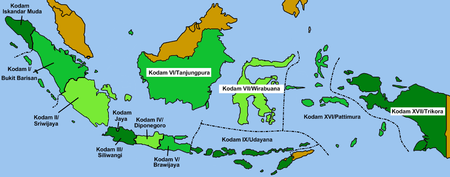
The Armed Forces' Military districts known as "KODAM"s and the operational organization of these were established by General Soedirman, following the model of the German Wehrkreise system. The system was later codified in Surat Perintah Siasat No.1, signed into doctrine by General Soedirman in November 1948.
The Army's structure underwent various reorganisations throughout its early years. From 1946 to 1952 the Army was organized into a number of set combined arms divisions. These were further consolidated in 1951, and then dispersed in 1952. From 1952 to 1958-59, the Army was organised into seven Territorial Armies(Tentara & Teritoriums) composed of regiments and independent formations in the battalion level and below. In August 1958, the Indonesian Army reconsolidated its territorial organization. There were then established sixteen regional commands, which retained earlier divisional titles; the Siliwangi Division, for example, became Kodam VI/Siliwangi.[15] The RCs, then as in today, were subdivided administratively into Areas (the former territorial regiments), Districts (the former regimental battalions) and District Sectors, and operationally composed of a number of speciality battalions and in some regional commands, an infantry brigade.
A reorganisation in 1985 made significant changes in the army chain of command. The four multiservice Regional Defence Commands (Kowilhans) and the National Strategic Forces Command (Kostranas) were eliminated from the defence structure, re-establishing the Regional Military Command (Kodam) as the key organisation for strategic, tactical, and territorial operations for all services.[16] The chain of command flowed directly from the ABRI commander in chief via the Chief of Staff of the Army to the ten territorial commands' commanders, and then to subordinate army territorial commands.
The territorial commands incorporate provincial and district commands each with a number of infantry battalions, sometimes a cavalry battalion, artillery, or engineers, and there are an increasing number of infantry brigades being activated.[17] Some have Raider battalions attached. Currently there are 16 Military district commands in Indonesia:
- Kodam Iskandar Muda (Kodam IM): Headquartered in Banda Aceh, Aceh. The province of Aceh is under the jurisdiction of this territorial command.
- Kodam I/Bukit Barisan (Kodam I/BB): Headquartered in Medan, North Sumatra. The province of North Sumatra, West Sumatra, Riau and Riau Islands are under the jurisdiction of this territorial command.
- Kodam II/Sriwijaya: Headquartered in Palembang, South Sumatra. The province of South Sumatra, Jambi, Bengkulu, Bangka-Belitung Islands and Lampung are under the jurisdiction of this territorial command.
- Komando Daerah Militer Jayakarta: Headquartered in Cawang, Jakarta. The Special Capital Region of Jakarta including Depok and Tangerang are under the jurisdiction of this territorial command.
- Kodam III/Siliwangi: Headquartered in Bandung, West Java. The province of West Java, excluding Depok and Tangerang, and Banten are under the jurisdiction of this territorial command.
- Kodam IV/Diponegoro: Headquartered in Semarang, Central Java. The province of Central Java and the Special Region of Yogyakarta are under the jurisdiction of this territorial command.
- Kodam V/Brawijaya: Headquartered in Surabaya, East Java. The province of East Java is under the jurisdiction of this territorial command.
- Kodam VI/Mulawarman: Headquartered in Balikpapan, East Kalimantan. The province of East Kalimantan, South Kalimantan and North Kalimantan are under the jurisdiction of this territorial command.

- Kodam IX/Udayana: Headquartered in Denpasar, Bali. The province of Bali, West Nusa Tenggara and East Nusa Tenggara are under the jurisdiction of this territorial command. The former province of East Timor was also under the jurisdiction of Kodam IX/Udayana.
- Kodam XII/Tanjungpura: Headquartered in Pontianak, West Kalimantan. The province of West Kalimantan and Central Kalimantan are under the jurisdiction of this territorial command.
- Kodam XIII/Merdeka: Headquartered in Manado, North Sulawesi. The province of North Sulawesi, Central Sulawesi and Gorontalo are under the jurisdiction of this territorial command.
- Kodam XIV/Hasanuddin: Headquartered in Makassar, South Sulawesi. The province of South Sulawesi, Southeast Sulawesi and West Sulawesi are under the jurisdiction of this territorial command.
- Kodam XVI/Pattimura: Headquartered in Ambon, Maluku. The province of Maluku and North Maluku are under the jurisdiction of this territorial command.
- Kodam XVII/Cendrawasih: Headquartered in Jayapura, Papua. The province of Papua is under the jurisdiction of this territorial command.
- Kodam XVIII/Kasuari: Headquartered in Sorong, West Papua. The province of West Papua is under the jurisdiction of this territorial command.
Army Special Forces Command
![]()
Army Branches/Corps
Combat elements

- Infantry branch (INF): (Bahasa Indonesia: Infanteri) - The Infantry Branch is the principal and major unit of the Indonesian army combat element. The Infantry element is the largest and main combat troops within the Indonesian army. Kostrad and Kopassus are all part of this branch although it also consists of non-infantry units internally. In Indonesia, there are more than 100 Infantry Battalions spread throughout the country. Green berets are worn by Indonesian Army infantrymen. The Infantry of the Indonesian Army are under the auspices of the Infantry Weaponry Centre ("Pussenif") which is under the command of a major general. The Infantry branch of the Indonesian Army consists of huge numbers of units whereas the International Institute for Strategic Studies' Military Balance 2007 lists the Army with 2 brigades, (6 battalions), plus 60 other battalions in each Military districts ("Kodam") and nine battalions in Kostrad.[19]The elite infantry battalions of the Indonesian Army are called "Raider Battalions" (raised in 2003) which are specially trained in Raid and Air assault operations (including counter-terrorism, Extraction, Guerrilla and Close combat operations).[20] By strength and capabilities, 1 battalion of Raider infantry is equal to 3 regular infantry battalions combined. There are currently about 39 raider battalions in the Indonesian Army Infantry branch, with the strength of 650 to 800 men per-battalion. It is larger compared to regular infantry battalions which only consists about 450 to 570 infantrymen. Even as the Chief of Staff of the Army (Kasad) is planning in the future to qualify all Infantry battalions (except mechanized) as "Raider"-ready,[20]there are now mechanized battalions which are "Raider"-qualified in addition to their mechanized role.Infantry battalions in the Indonesian Army originates from different combat organisations or corps, there are several infantry battalions part of Kostrad and some are part of the territorial military commands, the same case also falls to Raider Infantry battalions. Currently, there are now 3 Airborne infantry brigades in the Indonesian Army which are all "Raider" qualified (called as: Para-raider), and are all part of the Kostrad corps. The Infantry beret colors of the Indonesian army are as shown below:
- Regular Infantry soldiers wear: Green Beret with crossed-rifle insignia
- Kostrad infantrymen wear: Green Beret with Kostrad emblem, (Airborne units are added a paratrooper wing insignia on the beret)
- Raider infantrymen wear: Dark Green beret with Raider bayonet emblem
- Mechanized Infantrymen wear: Dark Green beret with Mechanized Infantry emblem
There are today 5 types of Infantry battalions in the Indonesian Army, which are:
- Para-Raider Infantry Battalion (abbreviated "Yonif Para Raider"): are Airborne infantry battalions part of Kostrad which are also capable in Air assault and Raid operations.
- Mechanized-Raider Infantry Battalion (abbreviated "Yonif Mekanis Raider"): are Raider infantry battalions which are Mechanized that are special operations-capable which also can carry out urban warfare and ground mechanized infantry operations.
- Raider Infantry Battalion (abbreviated "Yonif Raider"): are infantry battalions which are basically trained for Raid warfare and Air assault operations.
- Mechanized Infantry Battalion (abbreviated "Yonif Mekanis"): are mobilized infantry battalions, equipped with APCs and IFVs.
- Infantry Battalion (abbreviated "Yonif"): are light Infantry battalions.
All infantrymen of the Indonesian National Armed Forces (TNI) have capabilities in Jungle warfare, including infantrymen from the Indonesian Marine Corps and Paskhas corps.
Combat support element
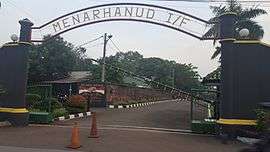

- Cavalry (KAV): (Bahasa Indonesia: Kavaleri) is the armored forces unit of the army. Its main function is as a combat support element. Cavalry units do not just rely on Tanks, APCs and IFVs as combat assets, but also use horses specially trained for combat and combat support operations in any terrain. Troopers wear black berets. The cavalry unit is under the Cavalry Weaponry Centre (Pussenkav).
- Field Artillery (ARM): (Bahasa Indonesia: Artileri Medan/ARMED) is the artillery unit of the army. It also acts as a combat support similar to the cavalry unit. Its main function is to support ground combat mission for the Infantry Branch. Brown berets are worn by its gunners. The Field Artillery unit is under the Field Artillery Weaponry Centre (Pussenarmed).
- Air Defense Artillery (ARH): (Bahasa Indonesia: Artileri Pertahanan Udara /Arhanud) are the anti-aircraft defense units of the army. Its main function to defend other ground units from an air attack and help to protect installations from destruction. Like the Field Artillery, Brown berets are worn by its gunners and missile crews. The Air Defense Artillery units report to the Air Defense Artillery Centre (Pussenarhanud). This unit has 4 detachments of Missile units called: "Den Rudal" (Detasemen Rudal).
Support elements
- Army Corps of Engineers (CZI): (Bahasa Indonesia: Zeni) - The Corps of Engineers is specialty branch of the army whose primary function as a combat support, such as the construction of military bridges for vehicles to pass by or converting highways into temporary runways. Another function of this unit is to expand troop movements and narrowing enemy movements while assisting friendly units. The Corps of Engineers are also involved in relief operations in the aftermath of calamities and in building civil projects in the local communities. Engineers, regardless of rank, wear Grey berets or construction helmets in their uniforms. The unit is under the Directorate of the Army Corps of Engineers.
- Ordnance Corps (CPL): (Bahasa Indonesia: Korps Peralatan) is a unit whose main function is the maintenance and testing of military ordnance. The unit is under the Directorate of the Army Ordnance Corps.
- Signal Corps (CHB): (Bahasa Indonesia: Korps Perhubungan) is a unit whose main function to deliver and maintain the best possible information to combat units. The unit is under the Directorate of the Army Signals Corps.
- Army Aviation Command (CPN): (Bahasa Indonesia: Korps Penerbang Angkatan Darat) - The army has its own small air arm that performs attack, liaison and transport duties. It operates 100 aircraft in five helicopter and aircraft squadrons composed mostly of light aircraft and small transports, such as the IPTN produced CN-235.
- 11th Squadron Heli Serbu (light assault) (Semarang)
- 21st Squadron Sena (support) (West Jakarta)
- 31st Squadron Heli Serbu (heavy assault squadron)(Semarang)
- 12th Squadron Heli Serbu (light assault) (Way Kanan Regency)
- 13th Squadron Serbu (Support) (Berau Regency)
Administrative Assistance Units

- Military Police Corps (CPM): (Bahasa Indonesia: Polisi Militer/PM) is categorized as for the administration assistance unit. Its main function is to maintain of discipline, law and order within the entire Army. MP units wear either light blue berets which are dragged to the left or blue MP helmets. The Military Police is under the Army Military Police Command.
- Adjutant General's Corps (CAJ): (Bahasa Indonesia: Korps Ajudan Jenderal) this unit's main function is for the administration of the military, public and military civil servants affairs. The adjutant general unit is under the Directorate of the Army Adjudant General.
- Logistics Transportation Corps (CBA): (Bahasa Indonesia: Bekang/Pembekalan Angkutan) This unit's main function is to provide services and transport logistic cargo within the Indonesian Army. Dark blue berets are worn by its personnel. The Logistic Transportation Corps is under the Directorate of the Army Logistics Corps.
- Topographic Corps (CTP): (Bahasa Indonesia: Korps Topografi) This unit's main function is to make topographic research and maps about the battlefield for the purposes of the Indonesian Army during combat. This unit is under the Directorate of the Army Topography Service
- Women's Army Corps (CWAD): (Bahasa Indonesia: Korps Wanita TNI-AD) Operationally dependent on Army commands and services the Women's Army Corps serves as the official administrative branch of women who actively spend their active military service in the ranks of the Army.
- Army Corps of Bandsmen (CMU) (Bahasa Indonesia: Korps Musik Upacara) - The Army Corps of Bandsmen, which is an administrative organization operationally dependent on Army commands and services, is responsible for the organization of the military bands, corps of drums and drum and bugle corps within the entire Army, alongside dedicated ensembles (big bands, rock and pop bands, native ensembles, etc.). Unlike the other support units these are under the direct control of their respective unit commanders as HQ units.
- Health and Medical Corps (CKM): (Bahasa Indonesia: Korps Kesehatan/Medis Militer) This unit's main function is to maintain the health and medical wellness of all Army officers, warrant officers, NCOs and enlisted personnel. and their families. The health unit is under the Army Medical Department.
- Finance Corps (CKU): (Bahasa Indonesia: Korps Keuangan) This unit's main function is to foster the financial administration of the army. The finance unit is under the Directorate of the Army Finance Corps.
- Judge Advocate General's Corps (CHK): (Bahasa Indonesia: Korps Hukum Militer) This unit's main function is to maintain law and justice within the army. The law unit is under the command of Directorate of the Army Justice Service. This unit is also responsible for military courts, and military attorneys and judges report under this unit.
Chief of Staff of the Army
Rank Structure
In the army, as well as in other armed forces branches in Indonesia, the rank consists of officer known as in Indonesian: "Perwira", NCO: "Bintara" and enlisted: "Tamtama".
The proper title to address of rank on official document are as follows, all high-ranking officers (General) use their rank followed by "(TNI)", while other officers use their rank followed by respective branch/corps abbreviation. For example, an Army colonel with Infantry branch use the title "Kolonel INF", while an Army Major General from Infantry branch use the title "Mayor Jendral (TNI)". Enlisted personnel are not required to put their respective branch/corps specialty.
Note: Indonesia is not a member of NATO, so there is not an official equivalence between the Indonesian military ranks and those defined by NATO. The displayed parallel is approximate and for illustration purposes only.
Officers
| Equivalent NATO code | OF-10 | OF-9 | OF-8 | OF-7 | OF-6 | OF-5 | OF-4 | OF-3 | OF-2 | OF-1 | OF(D) and student officer | |||||||||||||||||||||||||
|---|---|---|---|---|---|---|---|---|---|---|---|---|---|---|---|---|---|---|---|---|---|---|---|---|---|---|---|---|---|---|---|---|---|---|---|---|
(Edit) |
 |
 |
 |
 |
 |
 |
 |
 |
 |
 |
 |
No equivalent | ||||||||||||||||||||||||
| Jenderal Besar | Jenderal | Letnan Jenderal | Mayor Jenderal | Brigadir Jenderal | Kolonel | Letnan Kolonel | Mayor | Kapten | Letnan Satu | Letnan Dua | ||||||||||||||||||||||||||
| General of the Army | General | Lieutenant General | Major General | Brigadier General | Colonel | Lieutenant Colonel | Major | Captain | First Lieutenant | Second Lieutenant | ||||||||||||||||||||||||||
Enlisted
| Equivalent NATO Code | OR-9 | OR-8 | OR-7 | OR-6 | OR-5 | OR-4 | OR-3 | OR-2 | OR-1 | |||||||||||||||||||||||||||
|---|---|---|---|---|---|---|---|---|---|---|---|---|---|---|---|---|---|---|---|---|---|---|---|---|---|---|---|---|---|---|---|---|---|---|---|---|
(Edit) |
 |
 |
 |
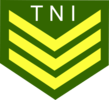 |
 |
 |
 |
 |
||||||||||||||||||||||||||||
| Pembantu Letnan Satu | Pembantu Letnan Dua | Sersan Mayor | Sersan Kepala | Sersan Satu | Sersan Dua | Kopral Kepala | Kopral Satu | Kopral Dua | Prajurit Kepala | Prajurit Satu | Prajurit Dua | |||||||||||||||||||||||||
| Chief Warrant Officer | Warrant Officer | Sergeant Major | Master Sergeant | Staff Sergeant | Sergeant | Master corporal | Corporal | Lance corporal | Master Private | Private First Class | Private | |||||||||||||||||||||||||
Equipment and Weaponry
Photo gallery
_NBO-105CB-4.jpg)
 Pindad APR-1
Pindad APR-1 Hanwha Defense Systems Tarantula
Hanwha Defense Systems Tarantula
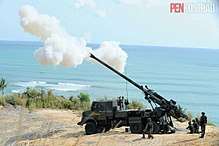 CAESAR self-propelled howitzer
CAESAR self-propelled howitzer- Arisgator
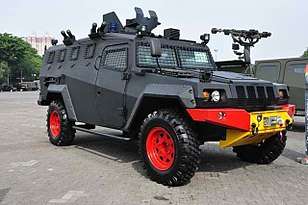
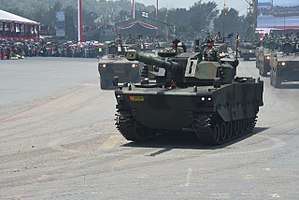 Pindad Harimau Hitam
Pindad Harimau Hitam
See also
Notes
References
- 1 2 IISS Military Balance 2012, 248. Figure may have not been updated by IISS since 2006 at least.
- ↑ Daves, Joseph H (2013) The Indonesian Army from Revolusi to Reformasi ISBN 978-1492930938, p 15
- 1 2 Schwarz, Adam (1994) A Nation in Waiting: Indonesia in the 1990s Allen & Unwin ISBN 1-86373-635-2, p 215
- 1 2 Hill-Smith, Charlie (2009) Strange Birds in Paradise: A West Papuan Story
- ↑ Ricklefs (1991), pages 214 – 215
- ↑ Friend (2003), page 35
- ↑ Reid (1974), page 78
- ↑ David A. Blumenthal and Timothy L. H. McCormack (2007). The Legacy of Nuremberg: Civilising Influence or Institutionalised Vengeance? (International Humanitarian Law). Martinus Nijhoff Publishers. ISBN 9004156917 pp. 80–81.
- ↑ "Criticism as Two Indonesian Soldiers Flee Lebanese, Israeli Battle in Taxi". The Jakarta Globe. 5 August 2010. Retrieved 10 February 2018.
- 1 2 IISS, The Military Balance 1976-77, p.55, ISBN 0-900492-98-8
- ↑ "Presidenial Decree No. 62/ 2016" (PDF). kemendagri.go.id. 14 July 2016. Retrieved 10 January 2018.
- ↑ Syukuran HUT Disjasad di Kodam Jaya, Pos Kota, 5 June 2013, retrieved 10 May 2017
- ↑ International Institute for Strategic Studies, The Military Balance 2008, 382.
- ↑ "Kostrad Exercise Chakra II forms 1.071 fighters (Latihan Cakra II Kostrad Cetak 1,071 Petarung)", Fery Setiawan, COMMANDO magazine 6th edition vol. XII 2016, p. 17, 2016
- ↑ Ken Conboy, Kopassus: Inside Indonesia's Special Forces, Equinox Publishing, Jakarta/Singapore, 2003, p.79
- ↑ Library of Congress Country Study, Indonesia, November 1992, Organization of the Armed Forces
- ↑ The Military Balance 2006, International Institute for Strategic Studies
- ↑ For further authoritative details on Kopassus, see Ken Conboy (2003) KOPASSUS Inside Indonesia's Special Forces, Equinox Publishing, ISBN 979-95898-8-6.
- ↑ IISS Military Balance 2007, Routledge for the IISS, London, p.352
- 1 2 http://www.siagaindonesia.com/149876/kasad-pembentukan-seluruh-yonif-non-mekanis-jajaran-tni-ad-jadi-yonif-raider.html
Bibliography
- Friend, Theodore (2003). Indonesian Destinies. The Belknap Press of Harvard University Press. ISBN 0-674-01834-6.
- Reid, Anthony. The Indonesian National Revolution 1945-1950. (Publisher: Longman Pty Ltd., Melbourne, 1974) ISBN 0-582-71046-4.
- Ricklefs, M.C. A History of Modern Indonesia Since c. 1300. (Second Edition. MacMillan, 1991)
Further reading
- Harold Crouch, The Army and Politics in Indonesia, Cornell University Press, Ithaca, New York, 1978
- Sukarti Rinakit, The Indonesian Military after the New Order, Nordic Institute of Asian Studies, Copenhagen and Singapore, 2005
External links
- IndoWiki KODAMs
- Official website of TNI-AD (Army)
- Unofficial site of Indonesian Armed Forces
- Unofficial site of Indonesian Special Forces
- Jane's Intelligence Review - January 1997 and March 1997
- Indonesian Civil-Military Relations - Civil-Military Relations in Post-Suharto Indonesia and the Implications for Democracy Today: A Preliminary Analysis
- Israel, Fauzi. Tactical Assault & Combat Training. 2008
- "ASEAN Armies Rifle Meet"
| Wikimedia Commons has media related to Indonesian Army. |

.svg.png)